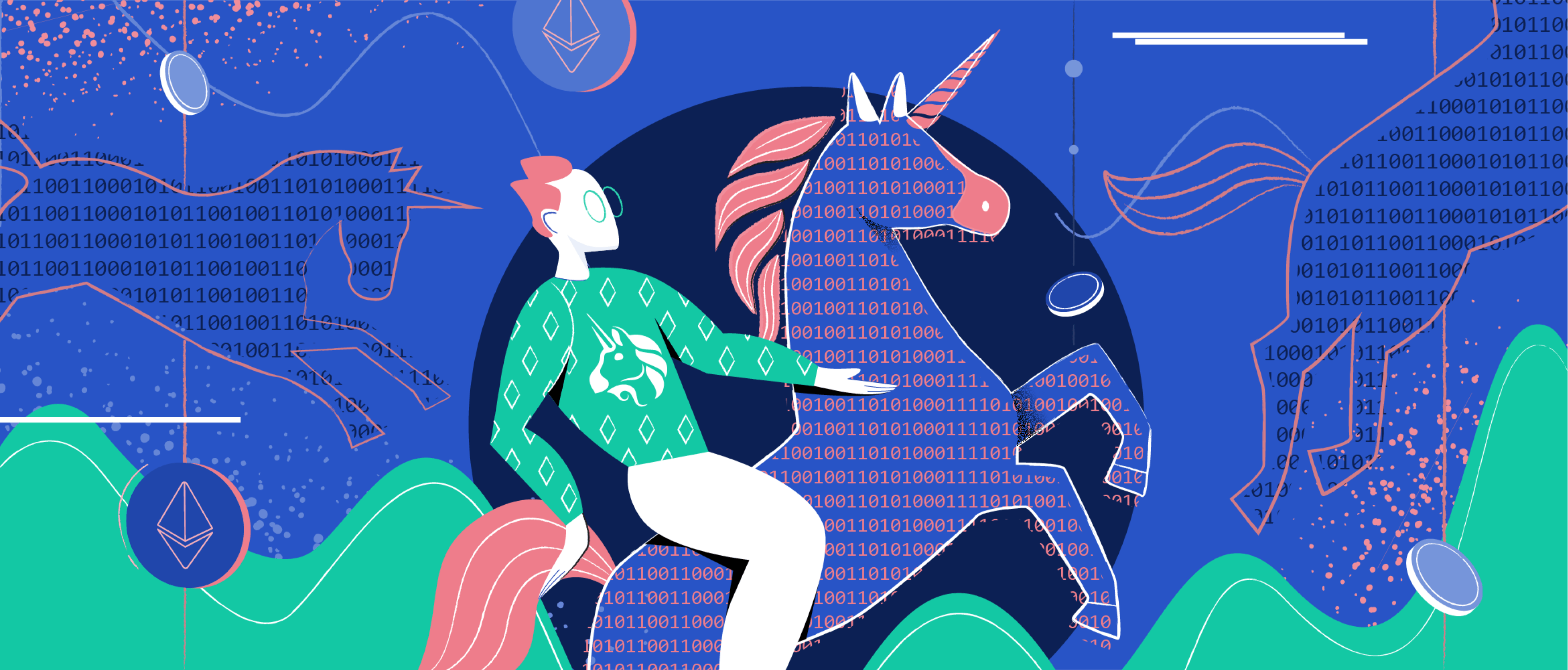
- All
- Tools
- Analytics
- Technical Analysis
- Trading
- Blockchain
- DeFi
- Guides
- Company News
- Educational
- Opinion
- Price Predictions
- Market News
- News
- Trading cases
- Practical guides
- Exchanges
- Trading signals
- Cryptocurrency
- Crypto bots
- Other
Become a crypto master
Learn everything about crypto,
trading and bots

What is Uniswap and How Does It Work?
Start Trading on 3Commas Today
Get full access to all 3Commas trading tools with free trial period

It is one of the few emerging decentralized cryptocurrency exchanges (DEX) that operate on the Ethereum blockchain and facilitate token swaps. Before we further explore Uniswap along with Uniswap token, let's first understand the problem it is attempting to solve.
The Liquidity Challenge
An overwhelming majority of cryptocurrency investment and trading is done through centralized exchanges like Binance or Coinbase. These services are owned and operated by a single organization which yields all the power. As a user, you are required to deposit and store your funds under a single entity's control which relies on a conventional order book for trading digital assets.
Order book system is where trade orders are accumulated and presented in a list that also includes the total amount of each order. The number of open trade orders for a particular cryptocurrency is referred to as 'market depth'. For a successful trade to occur through the order book system, every buy order must have a corresponding sell order featuring the same price and the amount of the digital currency.
The primary issue with the order book system is its liquidity. It means that at any given point, there might not be enough market depth i.e. the number of trade orders to fulfil every buy and sell order. This results in a poor trading experience as users fail to complete their buy and sell orders.
So What is Uniswap mean?
As mentioned in the introduction, Uniswap is a unique type of cryptocurrency exchange that is completely decentralized. It means that it is not owned and governed by a single organization. Built in 2018 on top of the Ethereum network, the exchange relies on a new trading model known as automated liquidity protocol. Since the exchange uses the Ethereum blockchain, it ensures compatibility with all ERC-20 coins as well as software applications including wallets.
One of the major advantages of Uniswap is that it is an open-source project so anyone can use the code to build their own decentralized crypto exchange. It enables users to list cryptocurrencies on the exchange at no cost which is completely opposite to centralized exchanges that are business-oriented and success-driven. They charge a high commission fee to list new tokens on their exchange.
Since Uniswap is a decentralized exchange or DEX, it means that traders can exercise complete control over their funds at all times and don't have to give up their private keys which are used to log orders on the centralized exchange's internal database. By having control over private keys, Uniswap reduces the risk of losing your digital assets if the exchange becomes a victim of a security breach. Currently, Uniswap v2 is the fourth largest decentralized finance (DeFi) exchange with more than $3 billion in crypto coins.
Uniswap Native Token - UNI
Just like any other blockchain, Uniswap also has a native token which is denoted by the initials of UNI and is used for governance primarily. Those who are holding UNI tokens have the right to vote on changes and new developments on the platform including how newly minted tokens should be distributed among the developers and community members along with changes to how the transaction charges are structured. The UNI token was officially launched in September 2020 to prevent users from opting for competing for decentralized exchanges.
At genesis, 1 billion UNI tokens were minted out of which 60% have been distributed among the existing Uniswap community members while 40% will be distributed among multiple stakeholders including investors, advisors, and team members over a period of 4 years. A portion of community distribution occurs through liquidity mining which means that UNI is given to those who provide liquidity to a wide range of pools including the following.
- ETH/USDT
- ETH/USDC
- ETH/WBTC
- ETH/DAI
How Does Uniswap Work?
The Role of Automated Liquidity Protocol in 2025
As we move through 2025, Uniswap's reliance on its automated liquidity protocol continues to offer a robust solution to the liquidity challenges that often beset centralized exchanges. This mechanism gains its efficiency by motivating users of the DEX to become liquidity providers (LPs). In this system, LPs collectively pool their digital assets, forming a consolidated fund designed to handle all buy and sell trades occurring on the platform. Every cryptocurrency available for trading possesses its distinct pool, allowing users the choice to contribute.
The beauty of the automated liquidity protocol is that it eliminates the necessity for both buyers and sellers to wait for a matching counter-order. If the specific cryptocurrency pool they're targeting boasts ample liquidity, their order will be instantly processed at a preset price. LPs, having invested their resources into the pools, receive tokens mirroring their contribution. To illustrate, a $5,000 investment in an automated liquidity pool with a total of $100,000 grants you a token symbolizing 5% of that pool. This token can later be redeemed to claim a proportionate slice of the trading fees.
In terms of fees, Uniswap implements a consistent 0.30% charge on every transaction executed on its decentralized platform, redirecting it to the relevant liquidity pool. When LPs opt to withdraw, they obtain a fraction of the entire pool fees, mirroring their staked sum. Subsequently, the token representing their stake is nullified. Notably, the Uniswap v2 update introduced a discretionary protocol fee, which can be toggled on or off based on community consensus. This fee takes 0.05% from each transaction, funneling it into a Uniswap development fund to propel future advancements.
How Uniswap Determines the Token Price
Since decentralized exchanges don't use the order book system, there is an alternative system used to determine the price of each digital asset. It should be kept in mind that while the order book system matches the lowest seller with the highest buyer, Uniswap relies on an automated market maker protocol. This alternative system adjusts the price of digital coins based on their supply and demand which is determined through a mathematical equation. The equation works by increasing and decreasing the price of a particular digital asset based on the percentage of the coins present in its respective pool.
It is important to bear in mind that when a user adds a new ERC-20 token to the platform, they are not only required to add a particular amount of their selected ERC-20 token but an identical amount of another ERC-20 token as well to start the automated liquidity pool. The equation that determines the price of the coin is x*y=k, where the amount of the first ERC-20 token is x and the amount of the second ERC-20 token is y. K remains a constant which means its value doesn't change.
For instance, John wants to trade Bitcoin (BTC) for Ripple (XRP) relying on the Uniswap BTC/XRP pool. Now, John will add a large amount of BTC to the pool which will increase the share of BTC in the pool to XRP. Since K is constant, it means the price of XRP will increase while the price of BTC in the pool will decrease. So the more BTC John puts in, the less XRP he gets in exchange because the price of XRP will continue to increase. Another factor that affects the price change is the size of the liquidity pool. The more liquidity there is in a pool, the simpler it is to execute large orders without affecting the price as much.
Arbitrage Trading
Arbitrage traders are an important part of the Uniswap platform. These are the trades that find price discrepancies across a number of exchanges and capitalize on the opportunity to pocket a positive result. For instance, if Ethereum was trading on Coinbase for $2,000 and Kraken at $2,050, you can buy Ethereum on Coinbase and sell it on Kraken to make an easy success. If arbitrage trading is done in large volumes, traders can secure a substantial success without taking too much risk.
Arbitrage traders on Uniswap try to find cryptocurrencies that are trading below or above their market price because of large trades that generate asymmetry in the pool leading to price surge or reduction. Then they buy or sell such coins to be successful. What arbitrage traders do is bring the token price to its market price by buying or selling until the price aligns with the market price. This particular phenomenon involving arbitrage traders and an automated market maker system is what keeps Uniswap token prices aligned with the rest of the cryptocurrency exchanges.
How to Use Uniswap
Using Uniswap is comparatively easy and straightforward. You will need to set up an ERC-20 supported wallet such as Coinbase wallet, Fortmatic, Portis, WalletConnect, or MetaMask.
After you have set up one of the ERC-20 wallets, you need to transfer ETH tokens to it that will allow you to start trading on Uniswap and pay for gas (Ethereum transaction fees). Gas payments change from time to time in terms of price and they are usually based on the number of people using the network.
The majority of ERC-20 compatible wallets give you the options to choose the speed of paying through the Ethereum blockchain including slow, medium or fast. The slow option is the cheapest option while fast will set you back a substantial sum. On the other hand, the medium is somewhere in between the two. This will determine at what speed your transaction is completed by Ethereum network miners.
- Step 1 - Go to the official website https://www.uniswap.org.
- Step 2 - In the top right corner, you will see the "Use Uniswap" button. Click on that button.
- Step 3 - Once again in the top right corner, you will see "Connect Wallet". Use this button to select your wallet.
- Step 4 - Now log into your cryptocurrency wallet and let it connect to the Uniswap platform.
- Step 5 - After the wallet is connected, you will see an option to swap tokens directly. You can use the drop-down list next to the “to” and “from” sections.
- Step 6 - Now you can select the digital coin you want to swap. Enter the amount you'd like to exchange and click "swap".
- Step 7 - You will be presented with a preview screen so you can ensure all the details are correct. Once you are sure, confirm the transaction.
- Step 8 - Now you will need to wait for the transaction to be processed and added to the Ethereum blockchain.
Does Uniswap Make Money?
As a project, Uniswap does not make any money. It is a decentralized exchange protocol operated by Paradigm which is a cryptocurrency hedge fund. All transactional costs go to liquidity providers who can claim them at any time. Founders of the project don't get any cut from the transaction fees. As of now, the transaction fee that is paid to LPs is 0.30% for every trade.
The fee is added to the liquidity pool automatically which can be redeemed by the LPs anytime they want. The fees distributed among LPs is proportional to their stake in the respective pool. In Uniswap v2, a percentage of fees may be deducted for Uniswap development.
Final Word
In 2025, as the cryptocurrency landscape has matured, conventional exchanges, while acting as pillars supporting cryptocurrency investments and trading internationally, have also unintentionally spotlighted the significant issue of centralization. These platforms wield absolute dominion over users' digital assets, a centralized control that many in the crypto community view with skepticism. Uniswap, seizing upon this concern, provides a solution in the form of a decentralized exchange. Here, trades are not facilitated via a traditional order book but are navigated through an automated liquidity protocol. This approach decentralizes power since the protocol operates based on contributions from a myriad of liquidity providers (LPs), ensuring no singular entity or institution maintains overarching control.
By 2025, Uniswap's trajectory has been nothing short of impressive. While once in its nascent stages, it now ranks as the fourth-largest decentralized exchange, boasting an impressive average daily trade volume of $2 billion. The crypto community, traders, and investors alike are eagerly watching how the project's founders and contributors capitalize on their current momentum and steer Uniswap's future course.
Uniswap in 2025: Expanded Features and Strategic Integration with Automated Trading
Since its early days as a decentralized exchange, Uniswap has remained a core liquidity venue for both individual and institutional participants in DeFi. In 2025, Uniswap v4 introduces features that support deeper integrations with automated crypto trading bots and strategy automation tools used by professional traders, portfolio managers, and software providers like 3Commas.
Customization and Automation for Professional Users
The introduction of customizable hooks in Uniswap v4 allows developers to define advanced trading logic at the protocol level. This architecture enables better synergy with tools like crypto trading bot software, allowing users to deploy AI bot trading crypto strategies that react to market conditions in real time. Rather than relying on static liquidity positions, asset managers can use automated trading bots to adjust exposure dynamically across pairs and timeframes.
With these hooks, it’s now possible to:
- Create AI-based crypto trading bot strategies directly tied to Uniswap pools
- Incorporate bot signal trading mechanisms that respond to on-chain events
- Automate interactions with multiple liquidity pools across Ethereum, Arbitrum, and BNB Chain
- Execute cross-DEX arbitrage or correlation trades via auto crypto trading bot configurations
Enhanced Liquidity Management and Execution
Uniswap’s improved gas efficiency and consolidated liquidity architecture also reduce operational overhead for users running crypto auto trading setups or managing multiple bots. Professional traders who rely on crypto ai trading bots can now benefit from lower slippage and faster execution, especially when coordinating large-scale trades across stablecoins, altcoins, and LSTs (liquid staking tokens).
Asset managers leveraging platforms like 3Commas can now route strategies through Uniswap using crypto bot trading platforms that support webhook integrations, automated crypto trading apps, and execution logic tuned for market-making or directional strategies.
Strategic Implications
These advancements open up new capabilities for:
- Algorithmic hedge funds deploying ai crypto trading bots with multi-chain execution logic
- Trading desks seeking efficient, transparent access to DeFi liquidity
- Firms testing and optimizing automated cryptocurrency trading bot portfolios for risk-managed growth
As decentralized liquidity becomes increasingly programmable, Uniswap's evolution toward a modular, automation-ready infrastructure marks a pivotal shift. Traders no longer need to rely solely on CEX APIs or custodial systems to implement complex execution strategies—Uniswap v4 now supports a range of integrations tailored for crypto automated trading bots and signal-based execution engines.

A proven leader, successful at establishing operational excellence and building high-performance teams with a sharp focus on value creation and customer success.







